In the electric welding of metal heating, an electric arc is used. It occurs between the detail and the electrode - the core from the conductive metal (sometimes from non-metal). Metal mounted on the arc temperature. The zone of fusion in the location of the parts is called welded (welding) seam. For different metals and different types of compounds, the welding technique, the position of the electrode, the speed of its movement, amplitude can be changed. How to cook the seam, so that the connection is not only reliable, but also beautiful, let's talk on.
Types of welds and connections
The seams have a fairly extensive classification. First of all, they are divided by the type of making making. Depending on the requirements for reliability, the seam can be overlapped with one or both sides. With double-sided welding, the design is obtained more reliable and better keeps the form. If one seam is often it turns out that the product is thrown by: suture "pulls." If there are two of them, these forces are compensated.

Welded seams depending on the type of connection there are butt (online), brand, brazing and angular (to zoom in size, click on it right key mouse)
It is impassable to note that to obtain a high-quality weld, the metal should not be rusty. Because the places of welding are pre-soda or treated with a file - until the rust is completely disappeared. Next, depending on the requirements, random or not the edge.
Butt compound (seam-jack)
The seam in welding is used when connecting sheet metal or tubes. The parts are placed so that between them was a gap of 1-2 mm, if possible, hard fixed with clamps. In the process of welding, the gap is filled with molten metal.
A thin sheet metal - up to 4 mm thick - welded without prior preparation (stripping rust does not count, it is obligatory). In this case, boil only on the one hand. With the thickness of parts from 4 mm, the seam can be single or double, but the edge seal is required by one of the methods presented in the photo.

Types of preparation of parts when welding
- With a thickness of the part from 4 mm to 12 mm, the seam can be single. Then the edges are cleaned by any of the ways. It is more convenient with thickness up to 10 mm to make one-sided preparation, and thicker parts are cleaned more often in the form of the letter V. U-shaped stripper is more complicated in execution, therefore is less common. If the quality requirements are elevated, with a thickness of more than 6 mm, it is necessary to stripping on both sides and double seam with one and on the other side.
- When welding metal with a thickness of 12 mm, the double seam is accurately necessary, it is impossible to warm up such a layer on one side. Crimping the edges is double-sided, in the form of the letter X. Use with such a thickness V or U-shaped edges of the edges are unprofitable: to fill them take several times more metal. Due to which the consumption of electrodes increases and the welding speed is significantly reduced.
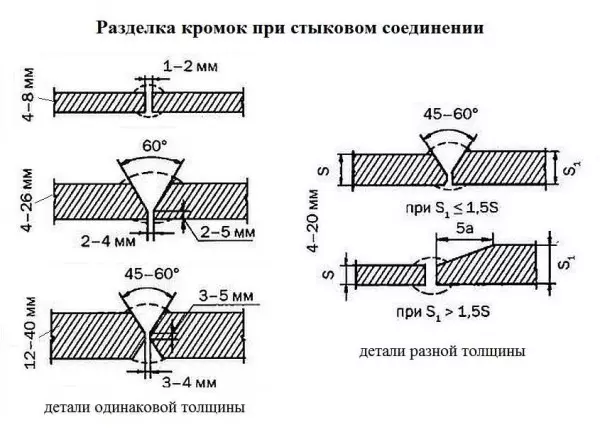
Cutting the edges of the metal when connecting the details of the online set (to zoom in the size of the picture, click on it right key mouse)
If still solved the metal of large thickness to cook with a one-sided cutting, filling the seam will need to be in several passages. Such seds are called multi-layered. As in this case, the preparation of the seam is shown in the figure below (the numbers are indicated by laying the layers of metal with welding).
About the welding of thin metal inverter welding machine here.
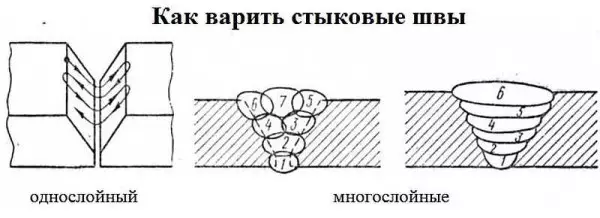
How to cook butt seam: single-layer and multi-layered (to zoom in the size of the picture, click on it right key mouse)
Connection of Vangest
This type of compound is used when welding sheet metal with a thickness of up to 8 mm. Boil it on both sides, so that there is no moisture between the sheets and there was no corrosion.
Article on the topic: How to plaster foam concrete - Technology of applying plaster on foam concrete walls
When performing a seam of a mustache, you need to select the electrode inclination angle correctly. It must be about 15-45 °. Then it turns out a reliable connection. With deviation in one direction or the other side, the bulk of the molten metal is not at the junction, but on the side, the strength of the connection is significantly reduced or the parts remain at all connected.
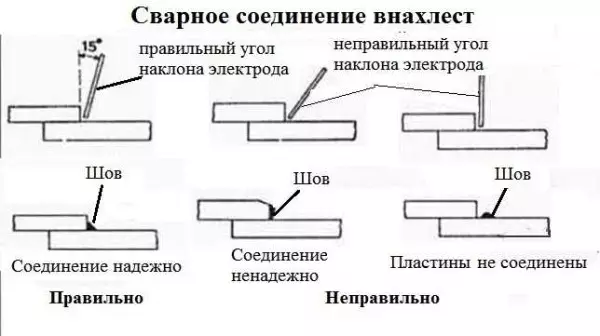
How to keep an electrode when welding a mustache (to increase the size of the picture, click on it right key mouse)
Taurus and angular connection
The brand connection in welding is the letter "T", the corner - the letter "g". The brand compound can be with one seam or two. The edges can also be separated or not. The need to cut the edge depends on the thickness of the welded parts and the number of seams:
- metal thickness up to 4 mm, seam single - without edge treatment;
- Thickness from 4 mm to 8 mm - without processing edges of seam double;
- from 4 mm to 12 mm - single seam with cutting on one side;
- From 12 mm the edge of spill on both sides, and the seam make two too.
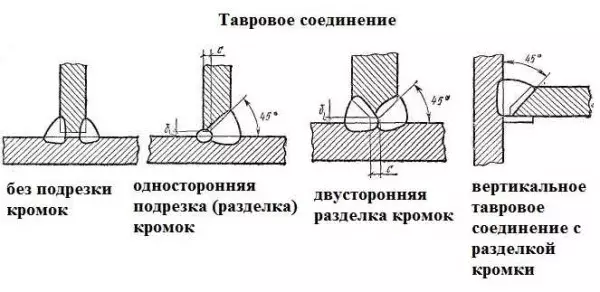
Types of welds: Taurope compound with cutting (trimming) edges and without
Corner seams can be viewed as part of the brand. The recommendations here are exactly the same: the thin metal can be welded without cutting edges, for greater thickness you have to take part from one or two sides.
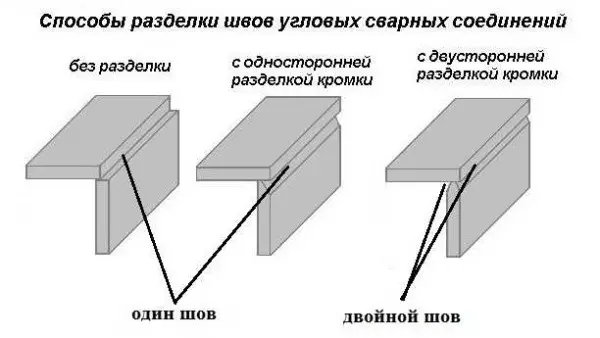
How to prepare metal for an angular connection (with one or two seams)
Corner and brass joints sometimes have to boil on both sides (two seams). In order to correctly cook such a seam, the parts rotate so that the metal planes are at the same angle. In the photo, this method is signed "in the boat". It is easier to calculate the movements of the electrode, especially a newcomer with welding.
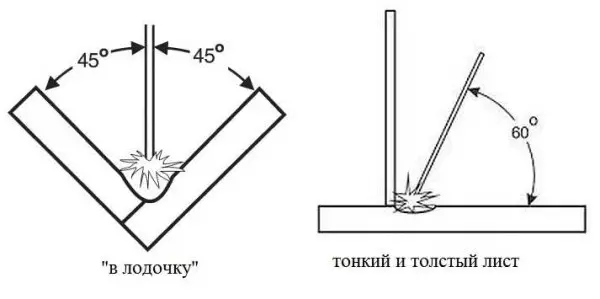
How to cook seam: "into the boat" and when connecting metals of different thickness
When connecting a thin and thick metal, the angle of inclination of the electrode must be different - about 60 ° to a thicker part. With this position, most of the warm-up will have to be on it, the thin metal does not burn, which can happen if the angle of inclination is 45 °.
Welding of corner seams
When welding angular seams, it is necessary to monitor the position and movement of the electrode. You must have a seam with uniform fill. It is easier to implement this if you put items for welding "into the boat", but this is not always obtained.
If the bottom plane is horizontally, it is often obtained that on the vertical plane, as well as in the very corner of the metal, it is not enough: it is down. This happens if at the top of the angle the electrode is less than the time of its side surfaces. The movement of the tip of the electrode must be uniform. The second reason is too large the diameter of the electrode, which does not allow to fall below and warm up the place of the junction.
To avoid the appearance of this defect arc in the horizontal surface (at the point "A"), moving the electrode to the vertical surface, then the circular motion return it to the place. When the electrode is above the junction, it has a tilt of 45 °, as it moves upwards, the angle slightly decreases (the picture on the picture on the left), when moving to a horizontal surface, an angle increases. With this technique, the seam will be filled evenly.
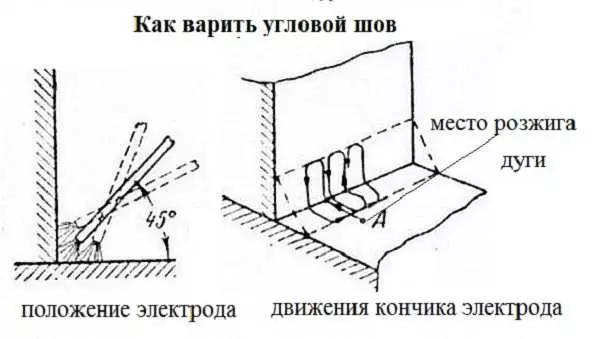
Corner welding - position and movement of the electrode
When welding angular connections, you also monitor the time of finding the electrode in all three points (on the sides and in the center) the same.
About choosing electrodes for inverter welding machines, read here.
Position in space
In addition to different types of compounds, the seams can be located differently in space. They are in the lower position. For the welder it is the most comfortable. So easiest to control the welded bath. All other positions are horizontal, vertical and ceiling seams - require certain knowledge of welding techniques (about how to cook such seams below).
Article on the topic: how to wash aluminum blinds
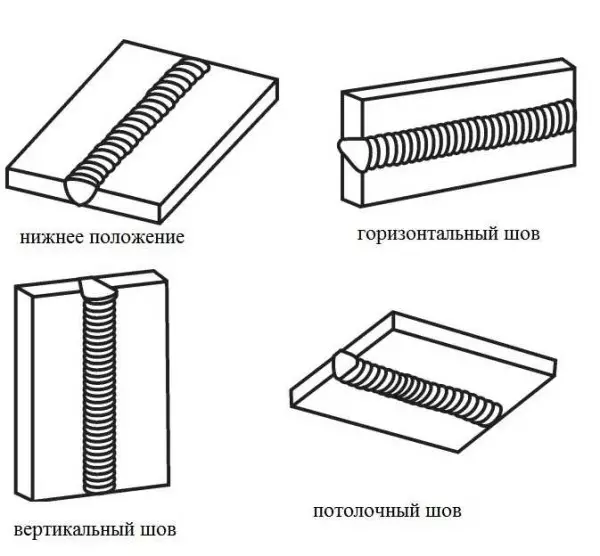
Types of welds on position in space: Vertical horizontal, ceiling
How to cook sow
When welding in the lower position, no difficulties occur even at a novice welder. But all other provisions require knowledge of technology. For each position there are recommendations. The technique of performing weld seams of each type is considered below.Welding vertical seams
During the welding of parts in a vertical position, the molten metal under the action of gravity slides down. To do not break off, use a shorter arc (the tip of the electrode is closer to the welded bath). Some wizards, if the electrodes allow (do not stick), in general they are based on the item.
Preparation of metal (edge cutting) is carried out in accordance with the type of connection and the thickness of the welded parts. Then they are fixed in a predetermined position, connected in increments of several centimeters with short transverse seams - "patches". These seams do not give details to shifts.
Vertical seams can be cooked from above-down or bottom-up. It is more convenient to work from the bottom-up: so the arc pushes a welded bath up, preventing it downwards down. It is easier to make high-quality seams.
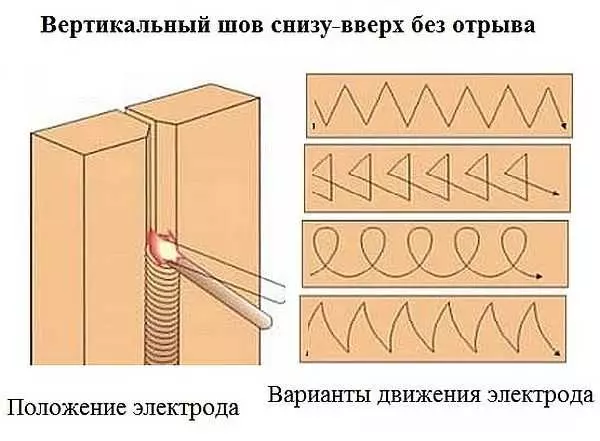
How to cook vertical seams from below: the position of the electrode and possible movements
In this video, it is shown how to properly cook the vertical seam of electrical welding with the movement of the electrode from the bottom-up without separation. A short roller technique is also demonstrated. In this case, the movement of the electrode occurs only up-down, without a horizontal displacement, the seam is obtained almost flat.
Perform the connection of parts in a vertical position with an arc separation. For beginners of welders, it may be more convenient: during the separation, the metal has time to cool. With this method, you can even describe the electrode on the welvic shelf. It's easier. The movement scheme is almost the same as without separation: from side to side, loops or "short roller" - up-down.
How to cook vertical seam with a margin, see the next video. In the same video tutorial, the effect of current force on the shape of the seam is shown. In general, the current must be 5-10 a less recommended for this type of electrode and metal thickness. But, as shown in the video, it is not always fair and is determined experimentally.
Sometimes the vertical seam is boiled down. In this case, when the arc is ignited, hold the electrode perpendicular to the surfaces of the surfaces. After the ignition in this position, warm the metal, then lower the electrode and boil already in this position. The welding of the vertical seam top-down is not very convenient, requires good control of the welded bath, but in this way you can achieve good results.
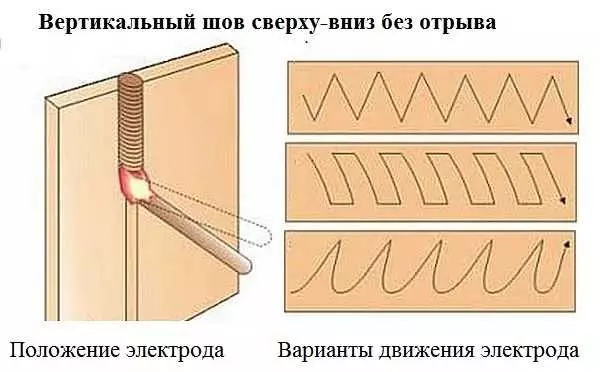
How to cook vertical seam electric welding top-down: position of the electrode and movement of his tip
How to cook horizontal seam
The horizontal seam on the vertical plane can be conducted both to the right-left and left-to-right. There is no difference, to whom it is more convenient, he is so cooking. As when welding the vertical seam, the bath will strive down. Because the angle of inclination of the electrode is large enough. It is selected depending on the speed of movement and current parameters. The main thing is that the bath remains in place.
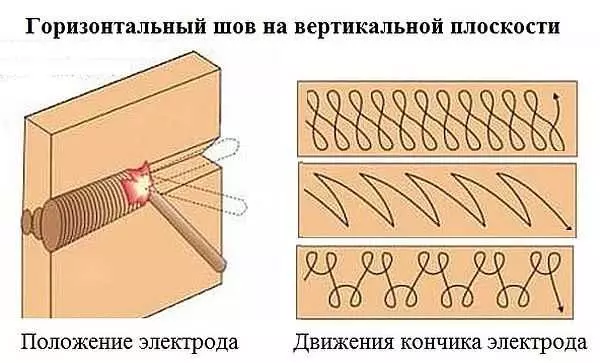
Welding horizontal seams: position of the electrode and movement
If the metal flows down, increase the speed of movement, less warming metal. Another way is to make an arc separation. During these short gaps, the metal coolers a little and does not flow. You can also slightly reduce current strength. Only all these measures apply stages, and not all at once.
In the video, it is shown below how to properly weld the metal in a horizontal position. The second part of the roller about vertical seams.
Ceiling seam
This type of welded connection is the most complicated. Requires high mastery and good control of the welded bath. To perform this seam, the electrode holds at right angles to the ceiling. The arc is short, the speed is constant. Perform mainly circular movements, expanding seams.Stripping welded seams
After welding on the surface of the metal, splashes of scale, metal drops and slag remain. The seam itself is usually convex, protrudes over the surface. All these shortcomings can be eliminated: clean it.
Article on the topic: Features of fixing timber
Stripping seams after welding make stages. At the first stage, with the help of a chisel and the hammer are knocked out the scale and slag from the surface. On the second, if necessary, compare the seam. Here you need tool: Bulgarian equipped with a grinding disk for metal. Depending on how smoothly the surface should be using different abrasive grain.
Sometimes, when welding plastic metals, a mud is required - the coating of the weld with a thin layer of molten tin.
Defects of welded seams
Beginner welders often occur when performing seams there are errors that lead to the appearance of defects. Some of them are critical, some - no. In any case, it is important to be able to determine the error to then fix it. The most common defects among beginners are an unequal width of the seam and its uneven filling. This is due to uneven movements of the tip of the electrode, changing the speed and amplitude of movements. As experience accumulates, these shortcomings are becoming less and less noticeable, after a while they disappear.
Other errors - when choosing the current and the size of the arc - can be determined in the form of a seam. In words, it is difficult to describe them, it's easier to depict. The photo below shows the main defects of the shape - sub-con and uneven filling, the reasons that caused them are prescribed.
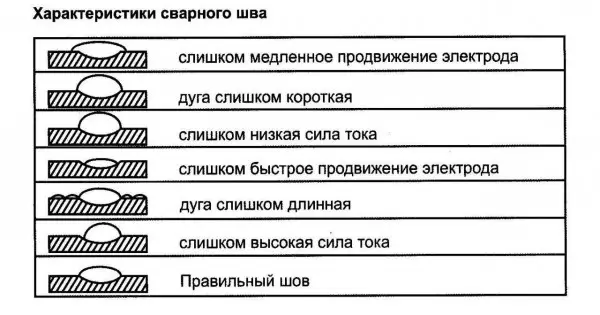
Errors that may occur when welding
Immersion
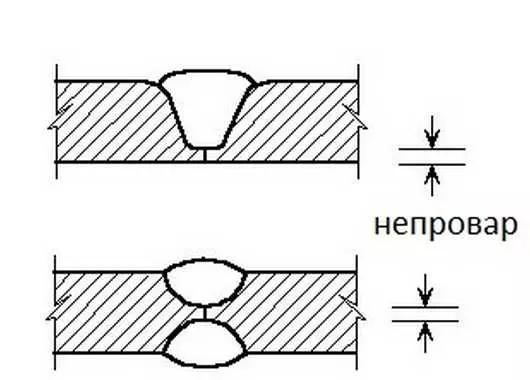
One of the errors that begin beginner welders: Never
This defect consists in incomplete filling the joint of the details. This drawback must be adjusted, as it affects the strength of the connection. Main reasons:
- insufficient welding current;
- high speed;
- Insufficient edge preparation (when welding thick metals).
Eliminated by adjusting the current and reduce the length of the arc. Featuring correctly all the parameters, get rid of such a phenomenon.
About choosing an inverter welding machine for home and cottages read here.
Sublica
This defect is the groove along the seam on the metal. Usually arise with a long arc. The seam becomes wide, the arc temperature for warming is not enough. Metal around the edges quickly freezes, forming these grooves. "It is treated" with a short arc or a current adjustment for the majority.
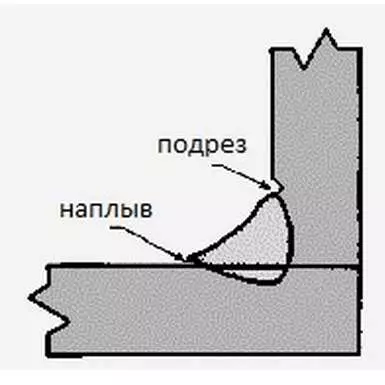
Corner Corner
With an angular or brand compound, the sub-conversion is formed due to the fact that the electrode is more directed to the vertical plane. Then the metal flows down, the groove is formed again, but for another reason: too strong heating of the vertical part of the seam. Eliminated by a decrease in current and / or arc shortening.
Burner
This is a through hole in the weld. Main reasons:
- Alloy the high current welding;
- insufficient speed;
- Too big gap between the edges.
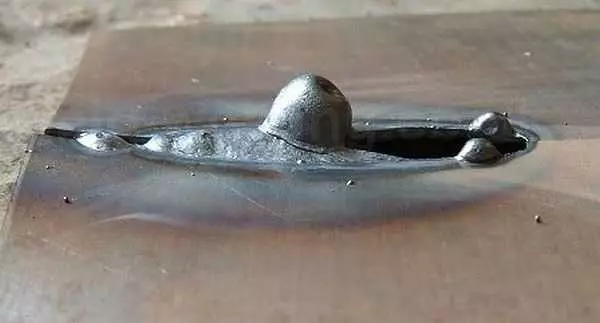
This looks like a fire seam when welding
Methods of correction are clear - we try to choose the optimal weld mode and the speed of the electrode.
Pores and influx
Pores look like small holes that can be grouped into a chain or be scattered over the entire surface of the seam. They are an unacceptable defect, as significantly reduce the strength of the compound.
Pores appear:
- With insufficient protection of the welded bath with an excessive amount of protective gases (low-quality electrodes);
- draft in the welding zone, which deflects the protective gases and oxygen falls into the molten metal;
- in the presence of pollution and rust on metal;
- Insufficient cutting edges.
Slops appear when welding with twisted wires with incorrectly selected modes and welding parameters. They are a striking metal that has not connected to the main part.
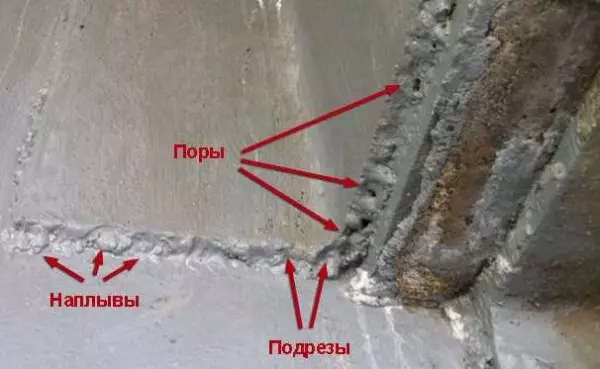
Basic Defects of Welded Swiss
Cold and hot cracks
Hot cracks appear in the process of cooled metal. Can be directed along or across the seam. Cold appear already on the cold seam in cases where the load for this type of seam is too high. Cold cracks lead to the destruction of the welded joint. These shortcomings are treated only by re-welding. If there are too many flaws, the seam is cut and overlap.
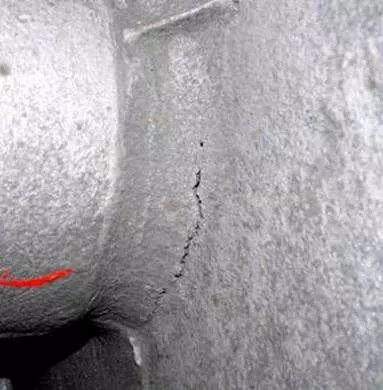
Cold cracks lead to the destruction of the product
The technique of welding inverter is described here.
